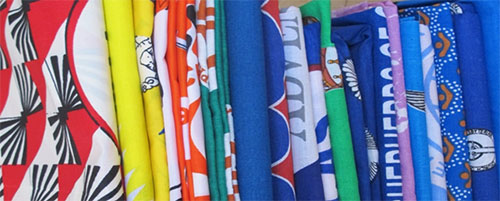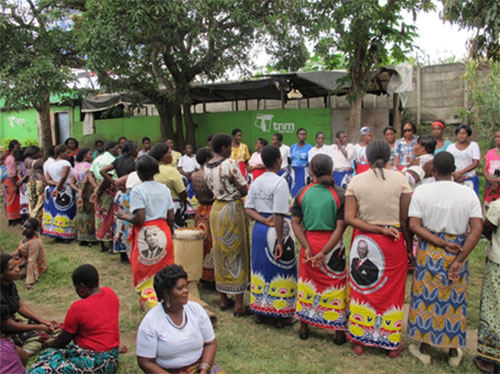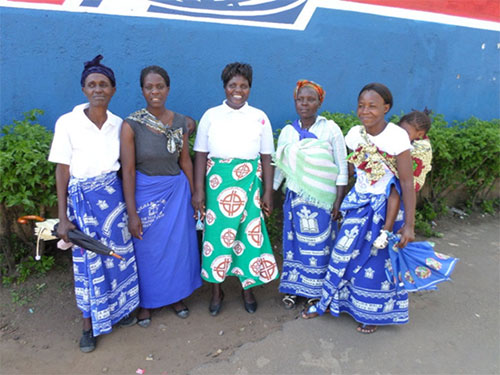Supported by an Art Fund Jonathan Ruffer curatorial award and National Museums Scotland, this April I returned to Blantyre in Malawi to continue work on a collecting and research project for the World Cultures African collections, working with Emmanuel Mwale from Museums of Malawi (MoM). The fieldwork had two strands: to collect the Malawian cloth known as chitenje (pl. kitenje), for the museum and to gain a greater understanding of the cultural significance of this cloth in Malawi today.
A chitenje is a length of patterned cotton cloth worn around the waist as a wrapper by many women every day in Malawi. Whilst this cloth is produced in a wide range of patterns and colours, my focus was on a range of cloths commissioned by the political parties and churches, which is distributed free (political) and sold to the public (church), and worn as an expression of support and unity.

Political cloth
There is a high level of interest in national politics amongst the general public in Malawi. With the General Election planned for 20 May 2014, there was significant activity in the run up to the election with rallies, campaigns and newspaper, television and radio coverage from all the main political parties in Malawi. Political cloth is distributed during campaign rallies as an incentive for party support.
Meetings at political party headquarters in Blantyre were arranged for all the main parties who will be contesting the election: People’s Party (PP), who are currently head of government; People’s Progressive Movement (PPM); Malawi Congress Party (MCP); Democratic People’s Party (DPP) and United Democratic Front (UDF). One of the highlights was an invitation to the Malawi Congress Party (Southern Party) headquarters in Blantyre to record the local women’s groups dancing and singing competition, to decide who would be representing the party at the election campaign launch in the capital Lilongwe. We collected donations of cloth from all the above.

Church cloth
In Malawi a very high proportion of the population regularly attend church and a large range of cloths are commissioned by the churches. These can range from celebrations for the inauguration of a new church building to commemorating a saint’s day; from new appointments of the clergy to annual church festivals including gospel singing. These are sold to members of the church to generate income for church funds.
During meetings and visits to a number of the local churches including Blantyre Synod Church Central Africa Presbyterian (CCAP); Seventh Day Adventist Church, Soche; Anglican Church Diocese Headquarters and Catholic Cathedral in nearby Limbe, it was clear that the church women are very active in the design of the cloths and emphasised the central role of church cloth in the expression of women’s community identity. This was very evident from the groups of women seen about, wearing the same designs, clearly and proudly identifying them with their local church.

Production
The most challenging element of the fieldwork plan, and one I most wanted to achieve, was organising an appointment to meet with the designers of these cloths, which are produced at the DWS Mapeto factory in Blantyre. After several attempts, a brief thirty minute visit was agreed, limited due to the high work load of the design studio and timed to the minute!
However, the visit resulted in an extremely valuable overview of the process of design from original customer’s sketch to finished full scale design, which is then passed to the machine engravers to produce the design plates for printing. A particular highlight was a quick look through the design catalogues which document each new numbered design. The designers gave us insights into the difference in working practice pre and post computer technology. This radically altered the design process and the number of staff in the office, which dropped from twenty to just four.

Fashion Design and Chitenje
The church and political cloth are sub-sets of the more decorative and widely used multi-coloured kitenje made and worn in Malawi. Whilst most are worn as a wrapper or tailored into a skirt and blouse outfit, they have also provided inspiration for Malawian fashion designers with an eye for the individual.
I read about Eva Gertrude Kapanda in an online newspaper article and went in search to talk to her about how the chitenje cloths inspired her work. I located her in her small studio shop premises in Blantyre, which is bursting with creations, from original one-off dress designs to bags, shoes and earrings from the second-hand European clothing market in Blantyre, which Eva reinvents or recycles by covering with brightly patterned chitenje. Like others I met she was very interested and enthusiastic to hear about this research. This was a great ending to a fascinating visit and I returned to National Museums Scotland with a number of originals from her studio to add a further contemporary dimension to the study and to the museum collection.
